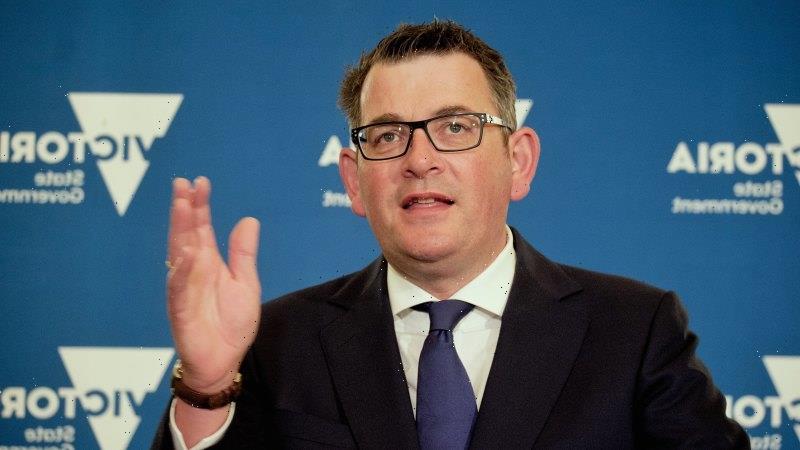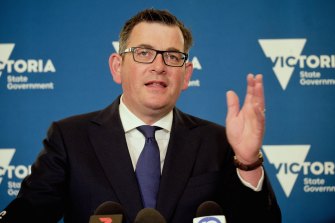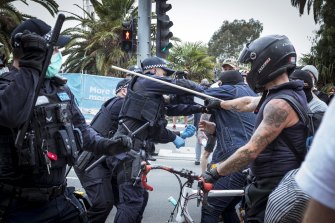For our free coronavirus pandemic coverage, learn more here.
Victorians have benefited from vaccination mandates of certain workers or as a temporary lockdown exemption that reduces spread when coverage is still too low. For a substantial public health gain, mandates may be justified.
But the Victorian government intends to extend the lockout of the unvaccinated throughout 2022. This is disproportionate to the risks the unvaccinated pose in a population that will reach at least 93 per cent two-dose coverage by year’s end.
Victorian Premier Daniel Andrews.Credit:Luis Enrique Ascui
We cannot lock out risk by locking out the unvaccinated indefinitely from everyday life. Vaccines should be part of a holistic response, alongside public health and social measures and robust testing, tracing, isolation and quarantine measures.
Victorians have emerged from what is likely to be the last of their restrictive statewide lockdowns. There is cause for celebration – at the rejuvenation of social and work life, the return of children to face-to-face schooling, and the sky-high vaccination coverage, reaching beyond all our expectations.
Nearly 90 per cent of Victorians have had two doses and this will climb. Victoria’s coverage rates between regions also have the least difference of any jurisdiction, showing the rollout has paid some attention to equity of access. The caveat here is that two-dose coverage for Aboriginal and Torres Strait Islander peoples in the state is 12 percentage points lower at 78 per cent.
After a reprieve, next winter may bring a COVID-19 surge that looks akin to a moderate influenza season – particularly with high booster take-up. But like the flu vaccine, some people will never take a COVID-19 vaccine. The question for governments is what to do about them.
Premier Daniel Andrews has made it clear that the unvaccinated over-12s in Victoria – currently 425,817 of them – don’t fit into social and cultural life for the duration of 2022. They cannot get a haircut, go to the movies, buy clothes at a department store, nor attend a gym. They cannot join their fully vaccinated partner or daughter at a restaurant. Their presence at a wedding or funeral will mean numbers capped at 50.
Except for the medically exempted, the lockdown and lockout does not end for the unvaccinated, meaning relative isolation and hardship for them will continue, along with the distress and conflict this can cause in their families. It also affects those policing the rules in all the restricted venues where all Victorians will continue to have to show their COVID-19 vaccination certificate each time.
It is easier to support harsh rules for vaccine refusers when people are angry with them. And people are angry. COVID-19 is a serious illness. The vaccines work and are mostly very safe. Most people overcame any concerns and vaccinated. Vaccines prevent our most social of diseases – infectious ones. A person may say they refuse to vaccinate. Another may hear this as: “I don’t care about your suffering from lockdowns nor your fears for the future.”
It is hard to sympathise with a group whose visible manifestation is the abusive, threatening and sometimes violent lockdown protesters brandishing nooses on our TV screens. Protesters and their political champions kick own goals by justifying calls for freedom of choice with false claims about vaccines. We need to decouple these ideas. Being against rigid vaccine mandates is not the same as being anti-vaccine.
Police and protesters clashed at a ‘Freedom Day’ protest in Melbourne.Credit:Chris Hopkins
There are times when vaccination requirements are warranted, such as for workers who care for those vulnerable to severe COVID-19 or for when we need to protect people while coverage is getting high enough.
The World Health Organisation’s Mike Ryan said last week: “Our position in WHO is that mandatory vaccination should only be considered if the health gain that you’re going to get from imposing that is very, very clear and that you’ve tried all other measures in order to get people vaccinated.
“If these types of mandates are implemented, they need to be implemented for the shortest possible period and … they need to be consistent with national public health and human rights law.”
Now that coverage is high and certain worker mandates are in place, the Victorian government is overreaching by extending the mandate for general citizens into 2022. There are signs the government may have recognised this overreach with the recent decision to allow all children aged 12 to 15 to their school excursions, camps and graduation ceremonies.
We need to approach 2022 with a holistic public health response. Governments must fulfil their responsibilities: to ensure those due for boosters can readily get them, and to maintain other public health and social measures like masks in crowded indoor public areas and adequate ventilation.
Testing, tracing, and isolation must continue to be well supported because the vaccinated can also get disease. Yet we see a shift towards making individuals responsible for managing their own contact tracing and isolation.
Vaccination is not an end unto itself. It is a means for improving societal health and wellbeing. So we should not undermine that higher goal on the way to reaching it.
Julie Leask is professor at the Susan Wakil school of nursing and midwifery at the University of Sydney. She is an adviser to the World Health Organisation on improving vaccination uptake.
Most Viewed in Politics
From our partners
Source: Read Full Article







